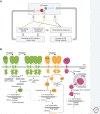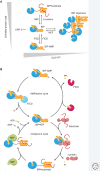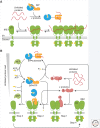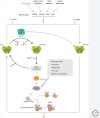Early Events in the Endoplasmic Reticulum Unfolded Protein Response
- PMID: 30396883
- PMCID: PMC6442202
- DOI: 10.1101/cshperspect.a033894
Early Events in the Endoplasmic Reticulum Unfolded Protein Response
Erratum in
-
Erratum: Early Events in the Endoplasmic Reticulum Unfolded Protein Response.Cold Spring Harb Perspect Biol. 2018 Dec 3;10(12):a037309. doi: 10.1101/cshperspect.a037309. Cold Spring Harb Perspect Biol. 2018. PMID: 30510064 Free PMC article. No abstract available.
Abstract
The physiological consequences of the unfolded protein response (UPR) are mediated by changes in gene expression. Underlying them are rapid processes involving preexisting components. We review recent insights gained into the regulation of the endoplasmic reticulum (ER) Hsp70 chaperone BiP, whose incorporation into inactive oligomers and reversible AMPylation and de-AMPylation present a first line of response to fluctuating levels of unfolded proteins. BiP activity is tied to the regulation of the UPR transducers by a recently discovered cycle of ER-localized, J protein-mediated formation of a repressive IRE1-BiP complex, whose working we contrast to an alternative model for UPR regulation that relies on direct recognition of unfolded proteins. We conclude with a discussion of mechanisms that repress messenger RNA (mRNA) translation to limit the flux of newly synthesized proteins into the ER, a rapid adaptation that does not rely on new macromolecule biosynthesis.
Copyright © 2019 Cold Spring Harbor Laboratory Press; all rights reserved.
Figures





Similar articles
-
A J-Protein Co-chaperone Recruits BiP to Monomerize IRE1 and Repress the Unfolded Protein Response.Cell. 2017 Dec 14;171(7):1625-1637.e13. doi: 10.1016/j.cell.2017.10.040. Epub 2017 Nov 30. Cell. 2017. PMID: 29198525 Free PMC article.
-
Kinetic and structural parameters governing Fic-mediated adenylylation/AMPylation of the Hsp70 chaperone, BiP/GRP78.Cell Stress Chaperones. 2021 Jul;26(4):639-656. doi: 10.1007/s12192-021-01208-2. Epub 2021 May 3. Cell Stress Chaperones. 2021. PMID: 33942205 Free PMC article.
-
AMPylation and Endoplasmic Reticulum Protein Folding Homeostasis.Cold Spring Harb Perspect Biol. 2023 Mar 1;15(3):a041265. doi: 10.1101/cshperspect.a041265. Cold Spring Harb Perspect Biol. 2023. PMID: 36041787 Free PMC article. Review.
-
AMPylation matches BiP activity to client protein load in the endoplasmic reticulum.Elife. 2015 Dec 17;4:e12621. doi: 10.7554/eLife.12621. Elife. 2015. PMID: 26673894 Free PMC article.
-
The endoplasmic reticulum (ER) chaperone BiP is a master regulator of ER functions: Getting by with a little help from ERdj friends.J Biol Chem. 2019 Feb 8;294(6):2098-2108. doi: 10.1074/jbc.REV118.002804. Epub 2018 Dec 18. J Biol Chem. 2019. PMID: 30563838 Free PMC article. Review.
Cited by
-
Increased cellular protein modification by methylglyoxal activates endoplasmic reticulum-based sensors of the unfolded protein response.Redox Biol. 2024 Feb;69:103025. doi: 10.1016/j.redox.2024.103025. Epub 2024 Jan 5. Redox Biol. 2024. PMID: 38199038 Free PMC article.
-
Production of an Active, Human Membrane Protein in Saccharomyces cerevisiae: Full-Length FICD.Int J Mol Sci. 2022 Feb 23;23(5):2458. doi: 10.3390/ijms23052458. Int J Mol Sci. 2022. PMID: 35269596 Free PMC article.
-
The endoplasmic reticulum unfolded protein response - homeostasis, cell death and evolution in virus infections.FEMS Microbiol Rev. 2021 Sep 8;45(5):fuab016. doi: 10.1093/femsre/fuab016. FEMS Microbiol Rev. 2021. PMID: 33765123 Free PMC article. Review.
-
Type I interferons and endoplasmic reticulum stress in health and disease.Int Rev Cell Mol Biol. 2020;350:63-118. doi: 10.1016/bs.ircmb.2019.10.004. Epub 2019 Nov 19. Int Rev Cell Mol Biol. 2020. PMID: 32138904 Free PMC article. Review.
-
Dynamic modulation of IRE1α-XBP1 signaling by adenovirus.bioRxiv [Preprint]. 2024 Dec 5:2024.11.30.626188. doi: 10.1101/2024.11.30.626188. bioRxiv. 2024. Update in: Pathogens. 2025 Feb 02;14(2):132. doi: 10.3390/pathogens14020132. PMID: 39677734 Free PMC article. Updated. Preprint.
References
-
- Abravaya K, Myers MP, Murphy SP, Morimoto RI. 1992. The human heat shock protein hsp70 interacts with HSF, the transcription factor that regulates heat shock gene expression. Genes Dev 6: 1153–1164. - PubMed
-
- Axten JM, Medina JR, Feng Y, Shu A, Romeril SP, Grant SW, Li WH, Heerding DA, Minthorn E, Mencken T, et al. 2012. Discovery of 7-Methyl-5-(1-{[3-(trifluoromethyl)phenyl]acetyl}-2,3-dihydro-1H-indol-5-yl)-7H-pyrrolo[2,3-d]pyrimidin-4-amine (GSK2606414), a potent and selective first-in-class inhibitor of protein kinase R (PKR)-like endoplasmic reticulum kinase (PERK). J Med Chem 55: 7193–7207. - PubMed
Publication types
MeSH terms
Substances
Grants and funding
LinkOut - more resources
Full Text Sources
